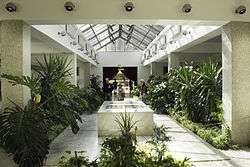House of Flowers (mausoleum)
| House of Flowers | |
|---|---|
|
Кућа цвећа Kuća cveća | |
 House of Flowers interior | |
| General information | |
| Type |
Mausoleum Museum |
| Location |
|
| Coordinates | 44°47′12.21″N 20°27′6.1″E / 44.7867250°N 20.451694°E |
| Completed | 1975 |
| Technical details | |
| Floor area | 902 m2 (9,710 sq ft) |
| Design and construction | |
| Architect | Stjepan Kralj |
House of Flowers (Serbo-Croatian: Kuća cveća or Kuća cvijeća, Кућа цвећа; Macedonian: Куќа на цвеќето; Slovene: Hiša cvetja) is the resting place of Marshal Josip Broz Tito (1892–1980), the President of the Socialist Federal Republic of Yugoslavia, and his wife Jovanka Broz (1924–2013). It is located on the grounds of the Museum of Yugoslav History in Dedinje, Belgrade, Serbia.
Name
The name House of Flowers comes from the fact that many flowers surrounded the tomb until it was closed to the public after the breakup of the Socialist Federal Republic of Yugoslavia. Today there are only white rocks where the flowers used to be. It was internally called "flower shop" during Tito's life when it served as his auxiliary office with covered garden.
History
"House of Flowers" was built in 1975, on the basis of the project by architect Stjepan Kralj. It was built as a winter garden with areas for work and rest of Josip Broz (area 902.00 m2) near the residence where he lived. It consists of three parts: a central - a flower garden, and a two parallel wide corridors on a sides. On the opposite side of the entrance is uncovered terrace with a view of Belgrade. In the central part, following his personal wish, Tito was buried in 1980.
Permanent exhibition in "House of Flowers" consist of local, republic and federal Relays of Youth from the period after the 1957, since when 25. May was celebrated as Youth Day. Beside that, written messages that Tito received with relays, photographs of carrying and transitions of batons, tickets and programs of rallies, and other related material are displayed in the museum.[1]
For almost a decade after the breakup of the Socialist Federal Republic of Yugoslavia the entire complex (the tomb and the memorial museum) was closed to the public and the military guards were permanently removed. However, today the site is open again to tourists and to people who wish to pay their respects. Many guests, from all over the former Yugoslavia, visit especially on May 25 (Tito's official birth date) - the former Youth Day under Socialism. The memorial was reportedly visited by more than eleven thousand people in 2004, and since 1982, more than 17,000,000 people.[2][3]
Gallery
- House of Flowers main entrance
 Interior of House of Flowers
Interior of House of Flowers House of Flowers museum, with Relays of Youth on the wall
House of Flowers museum, with Relays of Youth on the wall- Jovanka Broz tomb
 Honor guard of mausoleum
Honor guard of mausoleum
References
- ↑ Kuća cveća, at Noć Muzeja. (Serbian)
- ↑ Titovi poklonici opsedaju Kuću cveća (Serbian)
- ↑ Kuću cveća 2004. posetilo 11.000 ljudi (Serbian)
External links
| Wikimedia Commons has media related to House of flowers. |
Coordinates: 44°47′12″N 20°27′06″E / 44.78667°N 20.45167°E